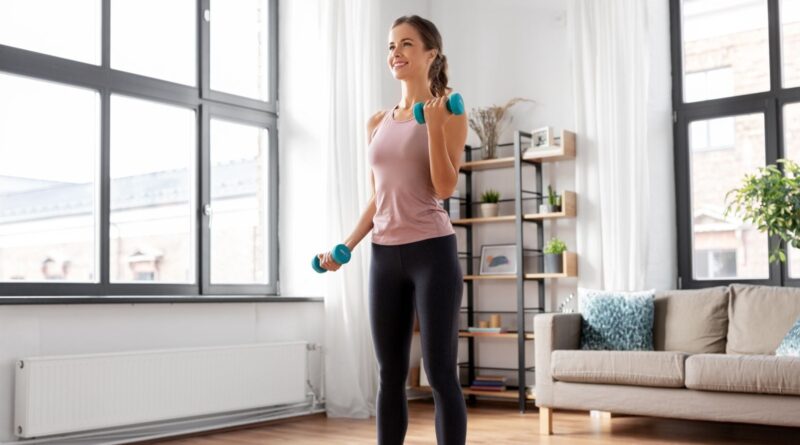Exercise for osteoporosis: 8 ways to keep your bones healthy
Simple exercise for osteoporosis such as walking, dancing, can help keep your bones healthy. Add them to your workout routine now!
Osteoporosis is a disease in which bones become fragile and prone to fractures. This is a common problem, especially among the elderly. Although there are medications prescribed for treatment, there are some basic activities that can help in that situation. Another regular exercise for osteoporosis includes weight training, which strengthens the muscles that support the skeletal system. This exercise promotes calcium in the bones and makes them dense and strong. In addition, they improve balance and coordination, reducing the risk of falling.
What is osteoporosis?
Osteoporosis, also known as the “silent thief of bones,” is a condition in which bones become brittle. It occurs when the body loses or produces too few bone cells, which causes a decrease in density, as found in a study published by StatPearls. The condition is often asymptomatic, meaning it may not be noticed until a fracture occurs, usually in the hip, back or arm. It is more common in older people, especially postmenopausal women, but it can affect anyone of any age or gender.

How does exercise help with osteoporosis?
Exercise plays an important role in maintaining healthy bones and joints. Weight-bearing exercise, such as walking, running, dancing and lifting weights, is especially beneficial, as found in a study published in the journal Missouri Medicine. Mahesh Ghanekar, a fitness expert, says: “These activities put them under stress, which stimulates the body to build new bone cells, thus increasing weight and strength.” In addition, physical activity helps maintain muscle strength and flexibility, which are important for supporting joints and improving balance. Strong muscles absorb shock and reduce stress on them, preventing injuries and arthritis. Regular exercise programs also improve joint lubrication and reduce inflammation, promoting good health and strong bones.
Best exercises for osteoporosis
Here are some good exercises you can try to prevent osteoporosis:
1. Walking
Walking is an excellent low-impact form of exercise that can benefit people with osteoporosis. As a strenuous exercise, it puts stress on the bones, stimulates the body to build new tissue and increase density. This helps strengthen the joints, especially in the legs, hips and back, which are common fracture sites for people with this condition. In addition, walking improves balance and coordination, reducing the risk of falling, which is a major concern for people with weak bones. It can also help maintain muscle strength, which is important for supporting joints and improving overall health.
2. Climbing the stairs
Stair climbing is an excellent weight-bearing exercise that can benefit people with this condition. As you go up each step, you use force on your bones, especially your legs, hips and back. This increased pressure causes the joints to grow and increase the mineral content of the bones, making them stronger and less likely to break. In addition, it improves balance and coordination, reducing the risk of falling, which is a major concern for people with this condition. It is important to start slowly and gradually build up strength and time to climb the stairs to avoid injury.
3. Dancing
Dancing is a great and fun exercise to add to your exercise routine, and it can be very beneficial for people with this condition. As with weight loss, it increases bone mineral density. This helps to strengthen them, especially in the affected areas. In addition, this type of exercise improves flexibility, balance, coordination, and reduces the risk of falls and improves overall physical performance. Its rhythmic movements can help improve mood and reduce stress.
You can also like


4. Wall push-ups
Wall push-ups are one of the best exercises for osteoporosis. It is a gentle way to strengthen the muscles of the upper body. By pushing the wall, you are actually doing a weight-bearing exercise, which promotes bone growth and increases density in the arms, shoulders and chest. This can help reduce the risk of fractures in these areas.
- Stand facing a wall, about an arm’s length away.
- Place your hands on the wall at shoulder height.
- Keep your feet flat on the floor, shoulder width apart.
- Bend your elbows, bringing your chest to the wall.
- Return to the starting position, straighten your arms.
5. Seated leg raises
Seated leg raises are a simple but effective exercise for strengthening the core and lower body muscles. In addition, it is gentle on the bones and joints, making it suitable for people with this disease. It can also help improve balance and coordination, reducing the risk of falling.
- Sit on the edge of a chair with your back straight and feet flat on the floor.
- Place your hands on your thighs or the sides of the chair for support.
- Lift one leg off the floor, keeping it straight, until it is level with the floor.
- Hold for a few seconds, then slowly lower your leg to the floor.
- Repeat with the other leg.
6. Sitting hand circles
Seated arm circles are a simple exercise to improve shoulder mobility and flexibility, both of which can be beneficial for people with the condition. It also helps maintain and improve shoulder mobility, reducing stiffness and pain.
- Sit up straight in a chair with your back straight.
- Stretch your arms out to the sides, parallel to the floor.
- Slowly make small, circular obstacles with your hands, moving them forward in a straight line.
- Continue the repetition for a few seconds, then reverse the direction and move your hands back counter-clockwise.
7. Bicep curls
Bicep curls are a challenging exercise that can be beneficial for people with this condition, as they help strengthen the muscles around the shoulders and upper arms. Strong muscles can help support bones and reduce the risk of fractures.
- Stand or sit straight, holding a light weight in each hand with your arms facing forward.
- Keep your elbows close to your body and your upper arms standing.
- Slowly bend the dumbbells to your shoulders, bending your elbows.
- Stop at the top of the movement, then slowly lower the weight back to the starting position.
8. Squats
Squats are a great strength training exercise that can help. As a compound body exercise, it works multiple muscle groups, including the quadriceps, hamstrings, glutes and core muscles. By putting stress on the bones, especially in the legs and hips, it causes growth and increases the strength of the bones.
- Start with your feet shoulder-width apart.
- Lower your body as if you are sitting on a chair, keeping your back straight.
- Make sure your knees don’t go past your toes.
- Pause at the bottom, then push back to the starting position.

Side effects of training for osteoporosis
Although exercise is important for bone health, it is important to be aware of possible side effects:
- Muscle aches: This is a common side effect of any new exercise routine, especially when increasing intensity or duration.
- Joint pain: Exercising excessively or improperly can lead to joint pain, especially in people with existing joint conditions.
- Fatigue: Excessive exercise can cause temporary fatigue, especially if you are not used to it.
How can you do orthopedic exercises safely?
Here are a few things to keep in mind while exercising to prevent injury.
- Contact a health care professional: Before starting any new exercise routine, talk to your doctor or physical therapist for personal advice.
- Start slowly and gradually increase the intensity: Start with low-impact exercises and gradually increase the intensity and duration as your body improves.
- Listen to your body: Pay attention to your body’s signals and avoid pushing yourself too hard.
- The correct format: Ensure proper structure and technique to avoid accidents.
- Choose low-impact exercise: Choose low-impact exercise such as walking, swimming and yoga to reduce the risk of fracture.
Although these exercises for osteoporosis are good for your bones, it is better to consult your doctor to avoid any problems.
#Exercise #osteoporosis #ways #bones #healthy
